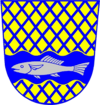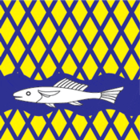Alajõe
| Alajõe | |||
|
|||
| State : |
|
||
| Circle : |
|
||
| Coordinates : | 59 ° 1 ′ N , 27 ° 26 ′ E | ||
| Area : | 109.61 km² | ||
| Residents : | 654 (2012) | ||
| Population density : | 6 inhabitants per km² | ||
| Time zone : | EET (UTC + 2) | ||
| Community type: | former rural community | ||
| Mayor : | Vladislav Ivanov
( Keskerakond ) |
||
| Postal address : | Valla 8 41001 Alajõe |
||
| Website : | |||

|
|||
The former rural community of Alajõe ( Alajõe vald ) was located in Ida-Viru County in northeast Estonia . In 2017 it was merged with four other rural communities to form the rural community of Alutaguse .
description
The rural community had an area of 109.61 km². 654 inhabitants lived in it (2012). Alajõe is located 22 km from the county capital, Jõhvi .
The municipality extended along the Peipussee . The municipal coat of arms also indicated the abundance of fish.
The sandy beaches on Lake Peipus and the extensive forest areas in particular attract many holidaymakers and nature lovers. 72 percent of the municipality is covered by forest.
Besides the old Vasnarva fortress, the Orthodox churches of Alajõe and Vasknarva are also worth seeing .
Villages
In addition to the main town of Alajõe , the rural community also included the villages of Karjamaa , Katase , Remniku , Smolnitsa , Uusküla and Vasknarva .
Vasknarva Fortress / Nyslott
In Vasknarva ( Vastne-Narva ), on the strategically important upper course of the Narva , the ruins of the old order castle of Vasknarva (Russian Syrenetz , Low German and Swedish Nyslott ) can be seen. This was built between 1427 and 1442. The fortress was built on the site of a previous building destroyed by Pleskauer troops, which was built by Herike in 1349 during the time of the order master Goswin .
The Ordensburg was almost razed to the ground during the Livonian War in the 16th century, but it was rebuilt. It was not until Sweden's victorious Russian-Swedish war (so-called Ingermanland War , 1610 to 1617) that it was completely destroyed and - as it was no longer necessary for strategic reasons - it was probably abandoned.
At the turn of the 17th and 18th centuries during the Northern War , it was only a ruin. Stones from the former fortress were used to build the Russian-speaking fishing village of Vasknarva.
Web links
- Official website (Estonian)
- Full description (Estonian)
Individual evidence
- ↑ Archived copy ( Memento of the original from September 21, 2011 in the Internet Archive ) Info: The archive link was inserted automatically and has not yet been checked. Please check the original and archive link according to the instructions and then remove this notice.


